When nothing goes as planned
Notes from the UNMUTE 2021 stage ft. Marla Woodward
If the last two years have taught us anything, it’s that life doesn’t always go as planned.
So it was only befitting when Marla Woodward, Head of Product Marketing at Attest, took over the UNMUTE stage to highlight some of the messier aspects of marketing and draw parallels between theatre and marketing.
Here’s a first-hand narration by Marla (truncated and edited for clarity):
Theatre Meets Marketing
In theatre, unpredictable things happen all the time—you’ve got a prompt that doesn't show up in the right place, you forget a line, somebody falls off, crazy things happen! How do you come back from that?
Turns out there are a couple of principles that theatre artists use in such situations:
- Thinking about the goal
- Working as a team
- Improv and experimentation
Thinking about the goal
When you're in a scene, you're always trying to accomplish something. You're trying to move the action on to the next scene, or to the next bit of drama, or a resolution, depending on where you're at the show. So anytime that you have to pivot or improvise, you always need to be thinking about what is it you're trying to accomplish.
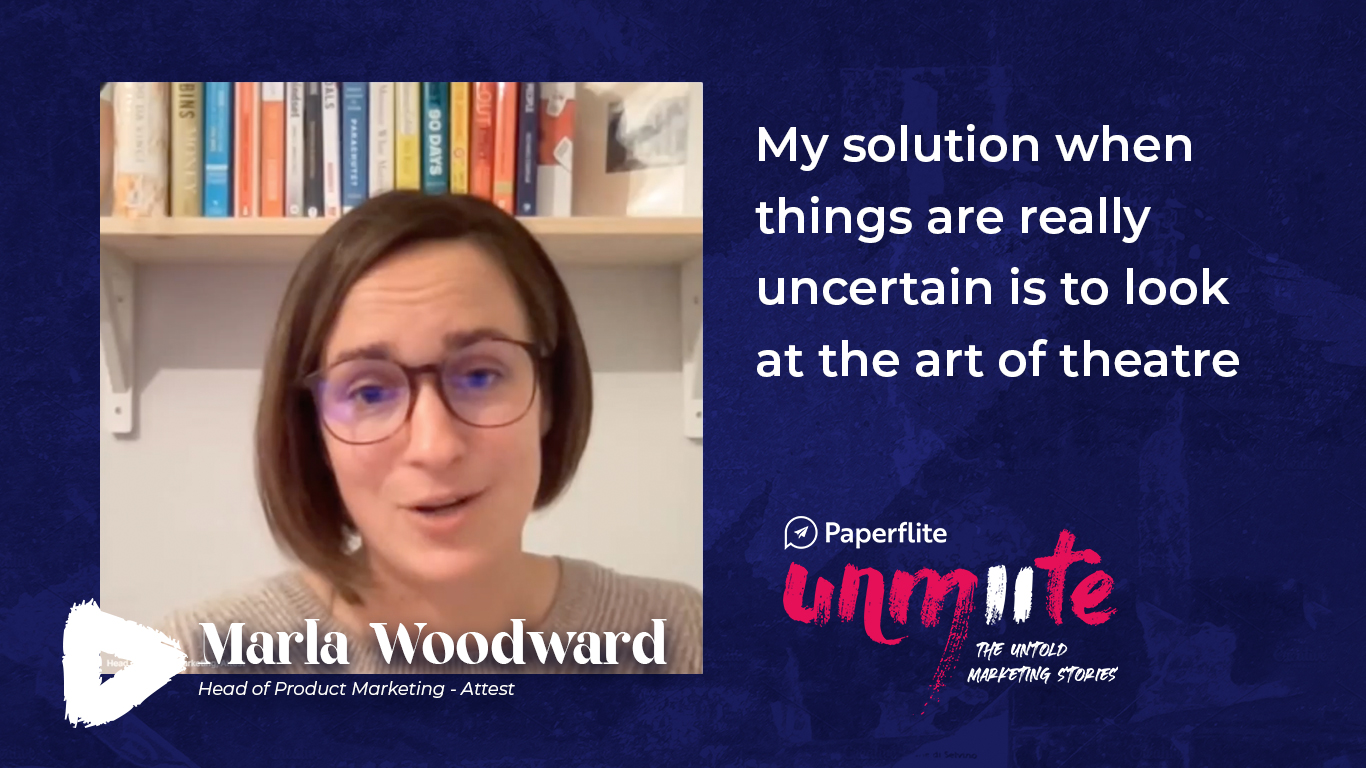
Working as a team
If you've ever been in a theatre production or worked on one, you'll realize there are people on the stage behind the scene. Everybody has to work together as a team and truly be empowered. Because there are times when things don't go right, somebody has to step in. When you forget a line, somebody else has to keep the dialogue moving, somebody forgets a prop, you have to improvise and find a way through the scene.
Improv and experimentation
Once you got the above two together, you've really got to figure out how you're going to make it through and make it work. What bits of dialogue can you use, even if it's not scripted, to keep the scene moving?
That's the framework I use whenever I'm in very uncertain situations. And as a result, tonight, I want to explore three personal stories from my experience.
And we'll ease in with the first one is going to be when things don't go as planned. But it turns out really well. So that's an easy story to tell. Right? They get progressively more awkward. The second story is going to be when things don't go as planned. And it wasn't a problem for me, but it was a real problem for a lot of my co-workers.
And lastly, I will stick the landing with probably the most terrifying moment of my career to date, what happens when things don't go as planned. And we'll talk about how I got through that and sort of what I've learned off the back of it. Let's start with something a little easier.
One Is Better Than Two
This first story takes place when I'm in my early 20s. I’m working at a large consumer packaged goods firm that's in the direct sales business model and my job is to help new people who started a business get up and running as fast as possible.
And I've been given a very simple question to answer - how do we improve our customer experience to increase new business owner activation? That's the goal.
As a part of this, we do a lot of discovery work, we look at pain points, all the data analysis we have. And among other things, a very simple, elegant solution presents itself.
We have this starter kit that’s comprised of literature and product. And the idea of it is to introduce sellers to the product so that they can go out and quickly start selling, except we have a problem. These two pieces ship from different places, the product is in a regional warehouse that is likely closer to the seller. But then the literature in the paper that explains all of these products come out of a different location.
So this is the experience these people are getting - they're receiving a box of product, no literature accompanies it, they have no idea what it is, probably consume half of the product, and then by the time they get the literature, they're kind of like losing interest. So we realized, this is probably a very simple customer experience fix that we just need to do.
However, I'm sure they split it up at one point to save money on shipping. So I'm going to have to make a business case that says, “I know it's more money. But let's do this to improve the experience”. Seems simple enough. There's one person who I need to help me execute this. And that is Debbie.
Debbie is our logistics manager and she needs to tell me how much more I need to pay in order to make this happen. So I do what a lot of 20-year-olds do - I email Debbie, and I say:
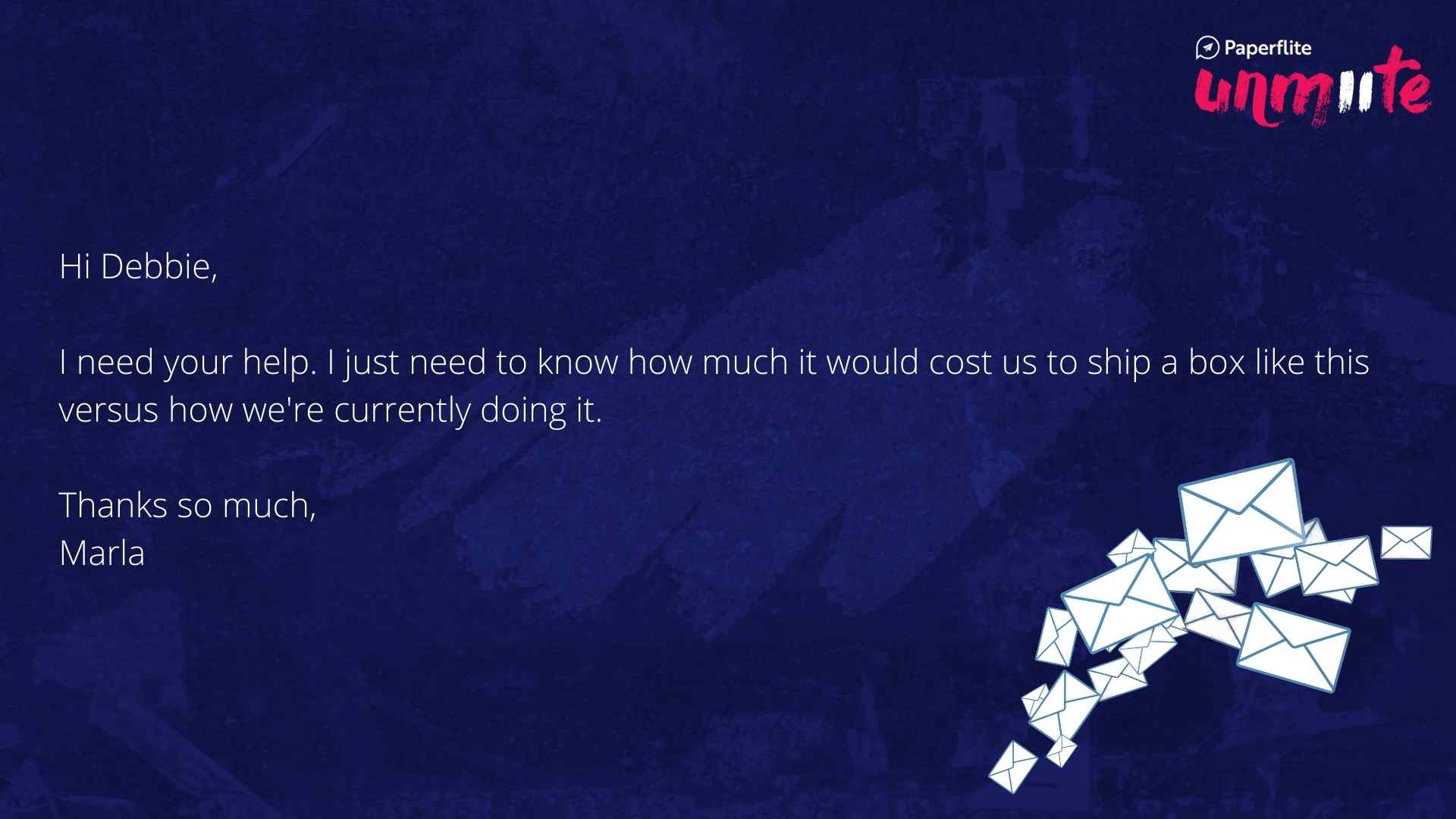
I don't know if you've ever received an email like that. Debbie didn't get back to me. Three days later, I'm still waiting for her response and I get nothing. And so I sent her a follow-up email:
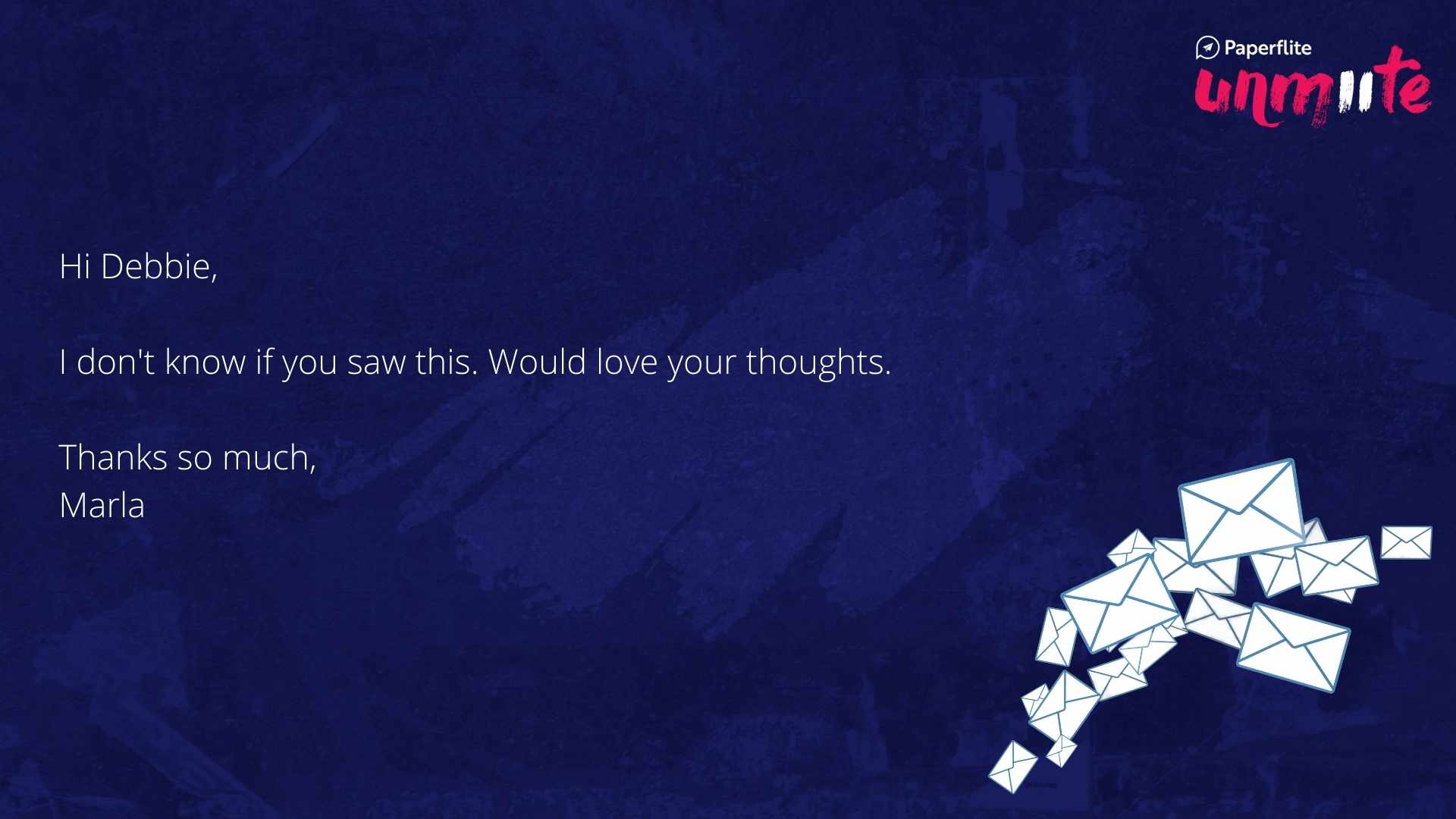
And that's when I realize I'm gonna have to go about this a different way and would have to improvise. So instead of emailing Debbie, I show up at her desk.
And I say, “Hey Debbie, I don't know if you got my emails. I could really use your help with answering this question”. She says, “Yeah, oh, your emails, not really a priority”.
It is at this moment, I realized I have not given Debbie any context or any reason to want to help me. All I've done is give her work, which she has no familiarity with. So I sit down and explain to her what we're trying to do. After a couple of days, Debbie gets back to me. She walks up to my desk, physically vibrating with excitement and I cannot overemphasize this!
She tells me that after running the numbers, we're actually going to save money by doing this. It turns out that we've changed the dimensions of this product box and made some other improvements to it by combining them and now our freight rates had changed. This means that we’ll be saving half a million dollars and improve the customer experience.
The learnings from that are pretty straightforward - Work as a team and focus on the goal. And the improvisation was just me figuring out how to communicate that in the first place. That's the easiest story to tell though.
Now we're gonna go into some of the messier ones.
Not All That Glitters Is Gold
This one is a story when things went really well for me, but maybe not for a bunch of my co-workers. When this happens, I'm working for an e-commerce company. I'm a Category Manager and my team is looking for something to drive revenue in a saturated category.
There was this great opportunity to lean in on one product that we already had - a premium gold foiled business card, it's very upmarket, differentiated. We wanted to expand it to other colours as well. Once that was decided, we set the goals for the launch - maximizing revenue and new customer acquisition.
So we're planning for the launch as much as we can and relying on the goal and teamwork to drive us. Everyone knows what the goal is and is feeling good about the launch. I did have to lower the revenue forecast ever so slightly so we didn’t have sky high expectations.
But, I think all of us including myself, underestimated even myself what we could accomplish. Since the product wash highly differentiated, it immediately took off! We were getting lots of responses and new customer acquisition, just by launching the new product alongside the little business card that we already had.
I'm watching the revenue, I'm feeling good about everything and can't wait for the next meeting where we're going to sit down as a team, and everyone's going to report based on their functional area, how they think the launch is going. So we walk into this meeting, I sit there and go, “Folks, I’ve been watching the revenue, you've done a fantastic job!” I'm applauding everyone but my operational counterparts across the table are sitting there and they do not look happy.
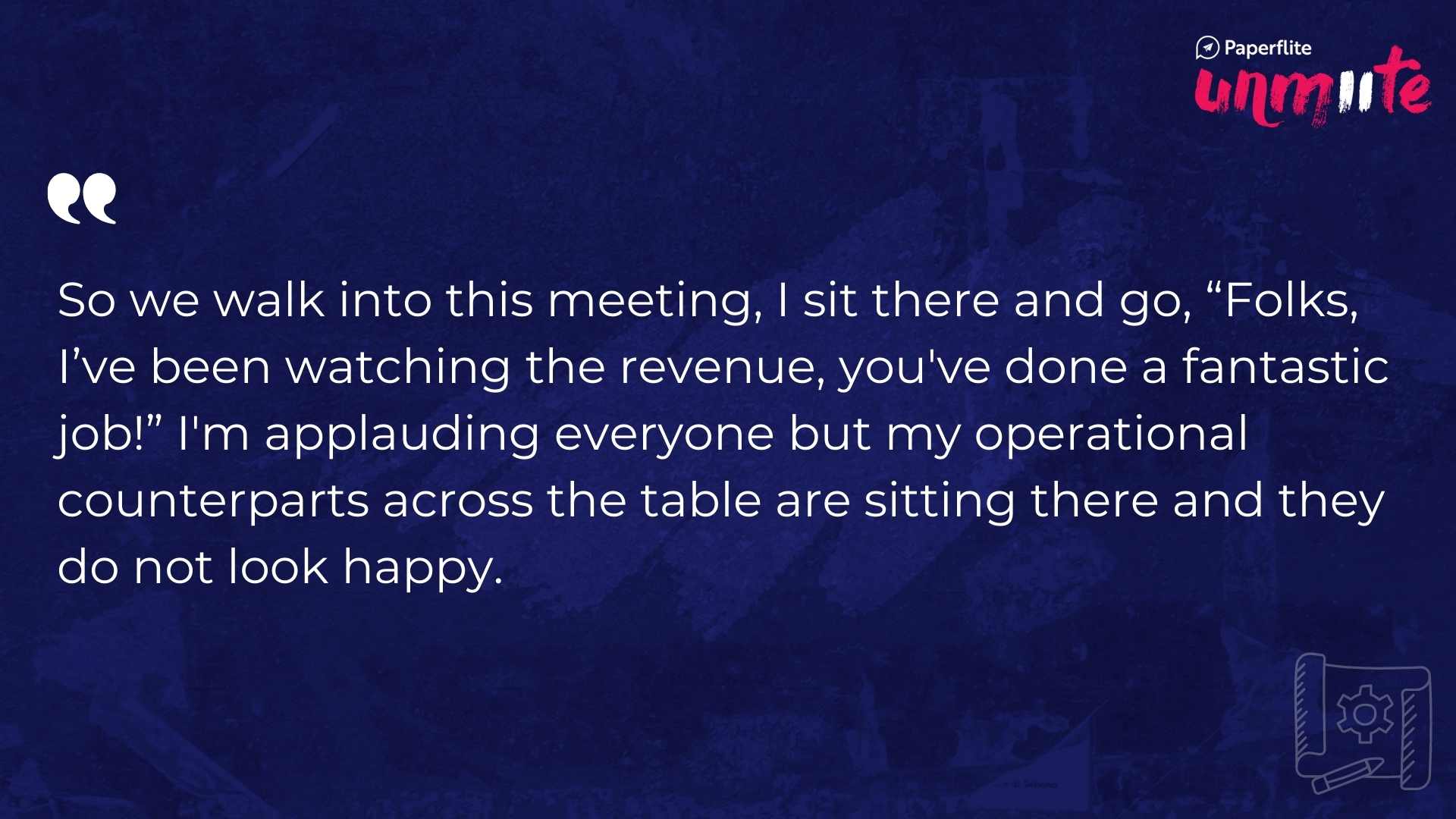
The fact that we've done well with revenue is actually stressing them out. The root cause we finally get down to as everyone's going through the reporting is we literally cannot produce this stuff faster because of a bottleneck - quality control.
We thought we had all the kinks worked out and we had a good QA process. But it turns out when you throw more into the system, the pressure causes it to break. And so what happens now?
All the new customers we acquired are gonna have a terrible experience because they're not going to get their product on time. So we needed to do something about it - immediately.
We go through all the options, reject a couple of them and finally land on the winning idea. It's very elegant, very straightforward - we increase the delivery time. Instead of a four day shipping, we increase it to five days. And just adding this one day buffer would give the ops team enough time to do thorough quality control.
And at the end of the day, when we implemented a one day increase, we didn't see a dark drop in revenue, we didn't see a drop in new customer acquisition. And honestly, when I look at that experience, I think it is such a great example of it not going as we planned.
But we knew what the goal of the project was, we had an empowered team that was willing to come to the table with solutions and felt like they could. And then we iterated, we improvised, and then eventually agreed and threw it out in the market. And it thankfully worked.
This brings us to the messiest story.
Lost in Translation
This happens in the middle of my career. To set the scene, I'm in my late 20s and in the Philippines. I’m moderating a research session that cost us thousands of dollars for my company. About 400 people are watching it live, including executives at the company that I'm at, and a $71 million account that we're trying to get on board.
I'm going through the intro questions but the audience draw a blank. There's not a lot of response, but there's a lot of whispering and talking between people at this moment.
And that’s when I realize that I'm in a room with people that can understand what I'm saying, but probably do not speak very much English at all. In fact, most of them speak Tagalog, a language that I don't speak. Again, remember the stakes, I have to make something out of this, there's not really a massive chance to just cancel the session, we're going to be out the money. I have to find a way to make this work.
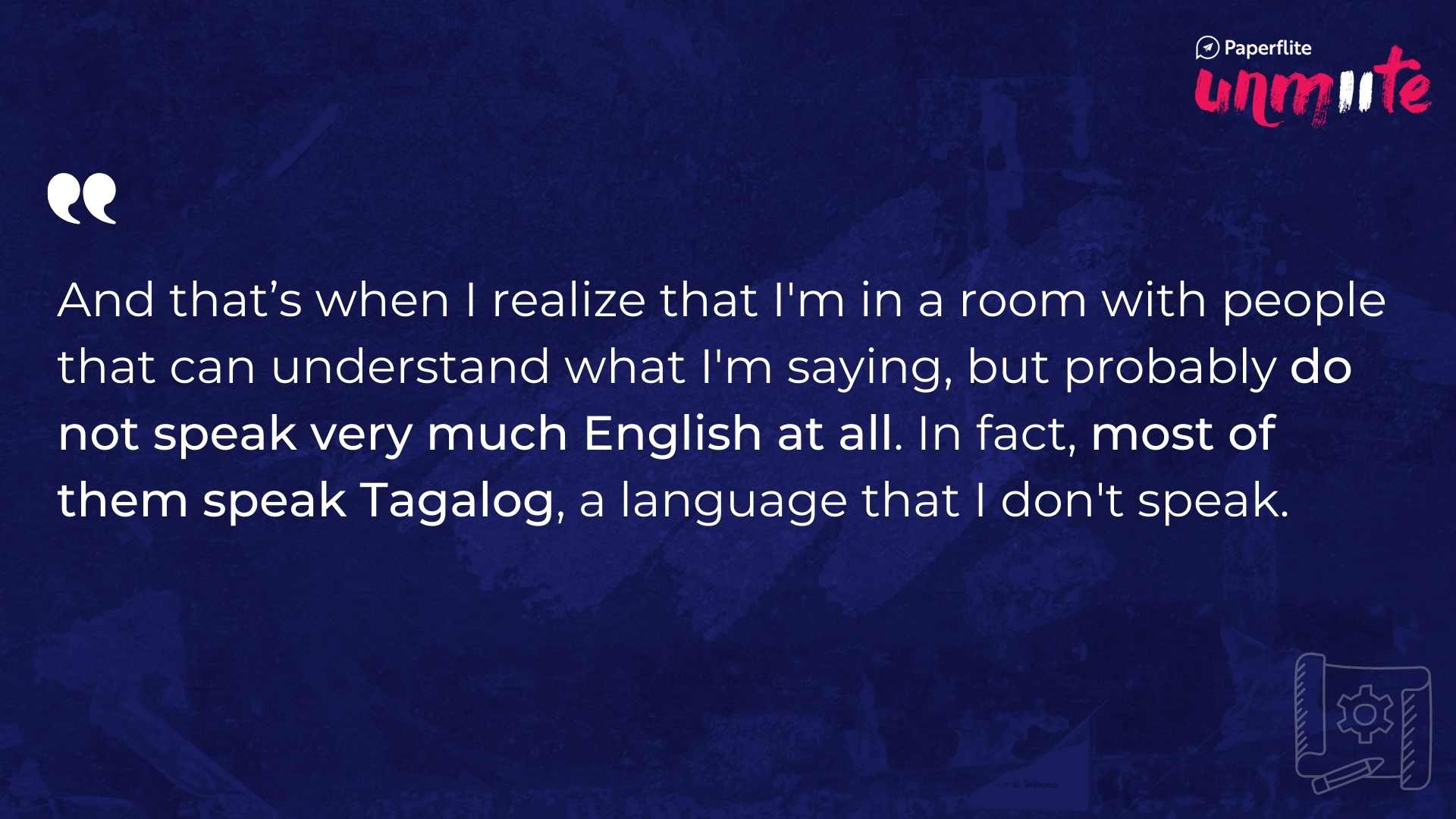
This is when I have a goal and I immediately pivot to experimentation and iteration. Okay, I need insights. I'm realizing qualitative is likely not going to get me there, because we're having trouble having a conversation. But maybe there's understanding and if I have understanding, I can get to maybe some quantitative feedback.
So I start instead of asking the open-ended questions, framing some of them and giving people ranges and responses, I am running on the fly with a quantitative survey. So for example, we're saying, “Well, how much would you be willing to pay for a product like this?” and we show them different ranges.
And all of a sudden, it becomes an insight to the people watching. Like “Oh, they're not willing to pay nearly as much as I thought they would, given the positioning that I've been using”.
We try other things around messaging and positioning, which messages and which reasons to believe actually resonate with this audience, listen to them, have them raise hands and vote. Oh, the way I've been positioning this, they don't seem to care about at all.
It is thankfully, at this moment, that we have already created an empowered team and my friend Stephanie sends in one of the local staff to help translate. And at this point, I realized I can now go back to the quantitative questions I have asked, and we can have a dialogue.
So during this whole session, absolute panic set in and it really required the three things I was talking about:
- I had to think about what my goal was with the session, just getting insights around this specific launch.
- Taking into account the constraints we had, I had to improvise and think of ways to accomplish that goal
- And I had an empowered team, Stephanie was able to send in local staff to get more context and to help us have a healthy dialogue that in the end, actually turned into a really successful session.
But at the moment, it did not look like it was going that well. Since then, we’ve learned some other little tips and tricks around cultural nuance and differences. We’ve also identified ways to need to build rapport with respondents even before the session in order to get them to open up in a more public forum.
So we implemented all of this, the session went really well, actually, three of our form messaging and product recommendations were adopted by these $71 million account, everything ended well. But oh, sweet heavens, that was the most terrifying moment of my entire career to date. So that's me, that's how I operate when things don't go as planned.
Other Notes from UNMUTE 2021
